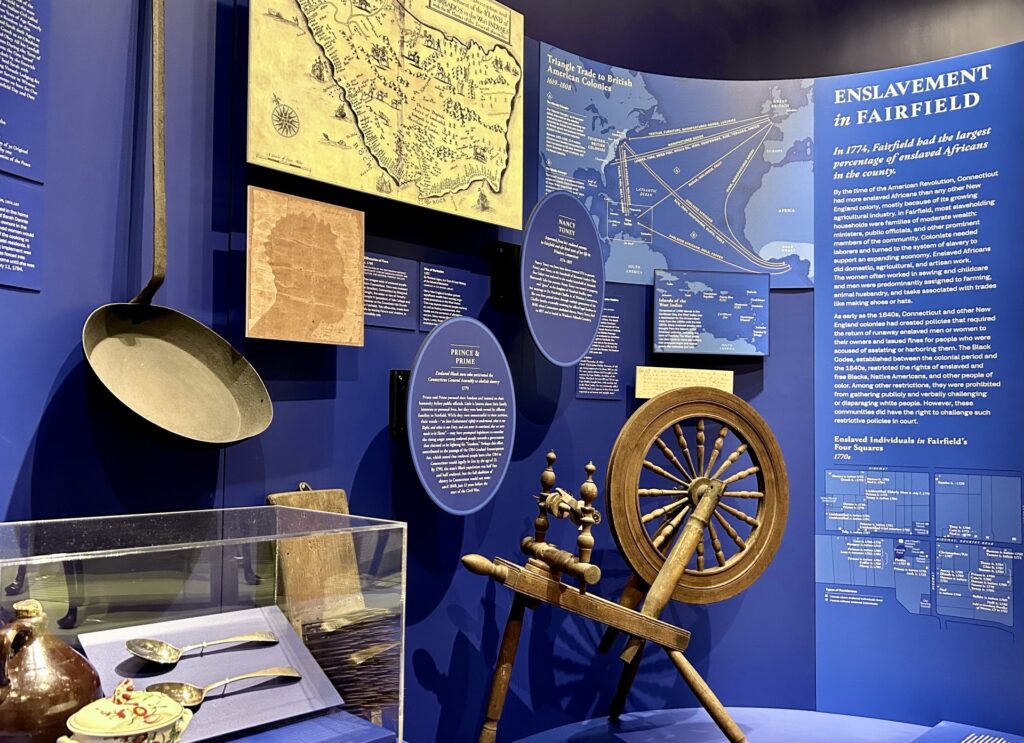Fairfield Enslaved Peoples Database
The Fairfield Museum and History Center celebrates the diverse history of our region and its people. As part of its mission, the Fairfield Museum seeks opportunities to better understand, preserve, and celebrate the previously hidden and overlooked parts of our past. After more than a decade of research and collaborating with diverse community partners, the Fairfield Museum recently re-opened our flagship exhibition Creating Community: 400 Years of Fairfield Stories, presenting a more complete and inclusive exploration of our shared history.
The Fairfield Museum is collaborating with a number of community partners, including Fairfield University, Beinecke Rare Book & Manuscript Library, and The Gilder Lehrman Center for the Study of Slavery, Resistance, and Abolition at Yale University, to make accessible a searchable genealogical database of more than 1,000 enslaved individuals who lived in Fairfield from 1639-1848 along with their immediate descendants and information on more than 400 slaveholders. The result of more than 30 years of research, the Fairfield Enslaved Peoples Database will be the most comprehensive and detailed genealogical database of its kind in Connecticut. The database builds upon the work of Dr. Vincent Rosivach, a professor at Fairfield University, and his students, who assembled primary sources such as probate, parochial, property, and newspaper records. It will provide students, scholars, and descendants of Connecticut’s enslaved people with the most comprehensive study of enslaved people in the state, offering unprecedented insight into this previously hidden aspect of southwestern CT history and genealogy.
Efforts are currently underway to raise the necessary funding to make this database accessible online. For more information, contact the Fairfield Museum’s Executive Director at (203) 259-1598.
Creation of the Enslaved People’s Database is made possible by the very generous support of:
- The Thomas & Jeanne Elmezzi Foundation
- Fairfield University
- CT Humanities
- Mr. Stephen Saft
- The Ernest and Joan Trefz Family Foundation
- The Office of the University Librarian, Yale University
The Legacy of Enslavement
When the Pequot War ended in 1637, Native Americans were among the first enslaved people in the area. In 1639, the first Africans were brought to Connecticut and enslaved. By the 1770s Fairfield was home to the largest percentage of enslaved Africans in the colony. Yet this history is not just about enslavement, but also how enslaved people built and protected their families and communities. Part of their legacy lies in their fierce advocacy for Black freedom and humanity, and their role in building and establishing the community we know as Fairfield today.
Visit the exhibition Creating Community: 400 Years of Fairfield Stories in person to learn more.
Enslavement in Fairfield
In 1774, Fairfield had the largest percentage of enslaved Africans in the colony.
By the time of the American Revolution, Connecticut had more enslaved Africans than any other New England colony, mostly because of its growing agricultural industry. In Fairfield, most slaveholding households were families of moderate wealth: ministers, public officials, and other prominent members of the community. Colonists needed laborers and turned to the system of slavery to support an expanding economy. Enslaved Africans did domestic, agricultural, and artisan work. The women often worked in sewing and childcare while men were predominantly assigned to farming, animal husbandry, and trades like making shoes or hats.
Fight for Family, Fight for Freedom
Life within the system of slavery was undoubtedly harsh and restrictive for those in bondage, and this was no different in Fairfield or Connecticut. However, enslaved people sought ways to keep their families together, find respite, and create unique traditions. In cases of desperation, enslaved Black men and women chose to take on those who challenged their families’ desires to stay together.
The sad truth was that separation was common in the system of slavery. To counter this reality and keep loved ones close or protected, enslaved people debated with their owners, took their cases to public officials, brought lawsuits to court, or made more radical or dangerous decisions like running away to reunite with loved ones.
Resources from Fairfield Museum
Explore the Fairfield Museum’s resources on enslavement in the region.
Interested in researching this topic? Schedule a visit to the Fairfield Museum’s Research Library by emailing us at [email protected].
Primary Sources
Photograph of Slave Quarters at Gold Selleck Silliman’s House
Exhibitions
Family/History: Exploring the Randolph-Ward Photographic Collection
Additional Resources
To learn more about enslavement in Connecticut, check out these additional resources from a variety of organizations:
Articles
ConnecticutHistory.org – Black Loyalist Refugees: Toney Escapes During the Burning of Fairfield
ConnecticutHistory.org – Nancy Toney’s Lifetime in Slavery
ConnecticutHistory.org – James Mars’ Words Illuminate the Cruelty of Slavery in New England
CT Explored – Reflections on the Emancipation Proclamation
Mattatuck Museum – Fortune’s Story
Local Organizations
The Mary & Eliza Freeman Center for History and Community
Gilder Lehrman Center for the Study of Slavery, Resistance, and Abolition at Yale University
Yale and Slavery Research Project
K-12 Lesson Plans & Resources
A Petition for Freedom in 1779
Abolition and African Americans in Connecticut
Connecticut’s Complicity in Slavery
Telling Their Stories: African Americans in the American Revolution
The Role of Enslaved People in Founding Connecticut
Understanding the Census: Tracking Connecticut’s Black Population
Resources on Slavery and Abolition
Resources on African American Heritage at Bridgeport History Center
Websites
Library of Congress -Voices Remembering Slavery: Freed People Tell Their Stories
Library of Congress – PDF of “Life of James Mars, a slave born and sold in Connecticut”
National Archives – Records that pertain to American Slavery and the International Slave Trade
Enslaved: Peoples of the Historical Slave Trade (Enslaved.org)
Yale Slavery and Abolition Portal

